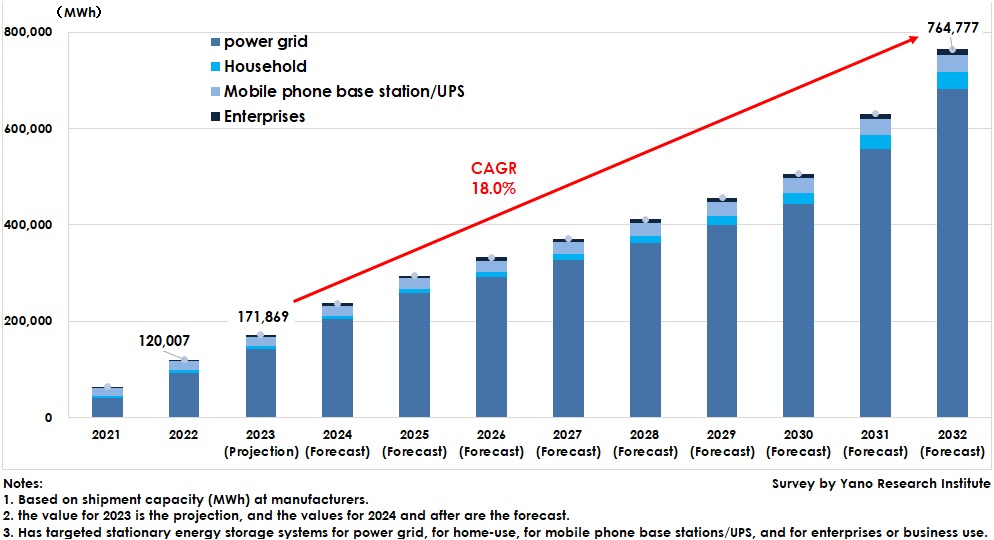No.3498
Global Market of Entire Stationary Energy Storage Systems (ESS): Key Research Findings 2024
Global ESS Market Size Based on Total Shipment Capacity Expects 764GWh for 2032
Yano Research Institute (the President, Takashi Mizukoshi) has conducted a survey on the global market stationary energy storage system (ESS) market for 2024 and found out the market trends by installed location and by application, the trends by battery type, the trends of market players, and the future perspectives.

Market Overview
The estimation of global market size of entire stationary energy storage systems (hereafter ESS) by shipment capacity at manufacturers in 2022 was 120,007 MWh. The year saw significant increase in demand for ESS, because of enhancement by the governments of major countries to support installations of renewable energy plants and ESS through subsidies and tax incentives, increased demand for producing and consuming electricity at households due to soaring electricity prices, decreased costs for generating electricity from renewable energy due to lower prices for solar panels, and improved profitability from selling electricity via reduced cost for renewable energy generation.
Continuously backed finantially by the governments in 2023, ESS deployment has continued growing to cater to increased installations of renewable energy plants in North America (the US in particular), Europe, and China. In addition, introduction of residential ESS is in progress in Japan, Europe, and North America, where electricity charges are relatively high. The global ESS market expects growth to reach 171,869 MWh in 2023, 143.2% on YoY.
Noteworthy Topics
Rapid Increase in Entry by Chinese Companies to ESS Projects Using Redox-Flow Batteries
A redox flow battery is a storage battery that charges and discharges electricity by circulating electrolyte. In addition to conventionally used vanadium, other redox flow batteries, i.e., iron-based, and those that use zinc bromide, iron-chromium, and galvanized iron, have been commercialized.
In recent years, development of establishing ESS technology to suppress the impact of long-term voltage fluctuations in power grids has been under way in China through incentive measures. This has increased entry to redox flow battery market by Chinese companies. Simultaneously, the ESS projects using the said battery have been made public in series. With too many market entrants in China, entry to redox flow battery market in China by companies from other countries seems to be more and more difficult. Meanwhile, Chinese enterprises that deal in redox flow batteries are likely to expand deployment overseas based on their achievements.
Future Outlook
To realize carbon neutrality, deployment of ESS will continue increasing. Meanwhile, efforts by ESS manufacturers to reduce costs will bring down the price of storage batteries, which expects demand expansion for ESS installations next to renewable energy plants.
CAGR for the global ESS market expects 18.0% from 2023 to 2032, with the global market size achieving 764,777MWh in manufacturer shipment capacity.
Research Outline
2.Research Object: Domestic and overseas manufacturers of and related to stationary energy storage systems
3.Research Methogology: Face-to-face interviews (including online interviews) by expert researchers and literature research
Stationary Energy Storage Systems (ESS)
This research has targeted the following types of ESS: Grid-scale (used at power plants/substations, renewable energy sources) aiming to stabilize power grid and for microgrid systems, Residential (used at detached houses or housing complexes such as condominiums and apartments), Business-use or commercial (used at companies for emergency electric sources, business continuity planning (BCP) measures, and for large-scale electricity demanders), and those used at telecom base stations or for uninterruptible power supply (UPS).
ESS for telecom base stations aim for load leveling and power stabilization to assure firm and smooth telecommunication environment for base stations. With 5G being fully commercialized, deployment of ESS has been underway as backup electric sources for stable electricity supplies and for building smooth communication environment.
ESS in this research refers to chemical energy storage system utilizing lithium-ion battery, lead storage battery, nickel hydrogen battery, redox flow (RF) battery, or sodium-based batteries (sodium-sulfur battery, sodium-nickel chloride battery, sodium-ion battery, sodium molten-salt battery, etc.)
*Reference:
Global Market of Grid-Scale Stationary Energy Storage Systems (ESS): Key Research Findings 2024
https://www.yanoresearch.com/en/press-release/show/press_id/3469
Global Market of Residential & Corporate/Commercial Stationary Energy Storage Systems (ESS): Key Research Findings 2024
https://www.yanoresearch.com/en/press-release/show/press_id/3482
<Products and Services in the Market>
Face-to-face interviews (including online interviews) by expert researchers and literature research
Published Report
Contact Us
The copyright and all other rights pertaining to this report belong to Yano Research Institute.
Please contact our PR team when quoting the report contents for the purpose other than media coverage.
Depending on the purpose of using our report, we may ask you to present your sentences for confirmation beforehand.